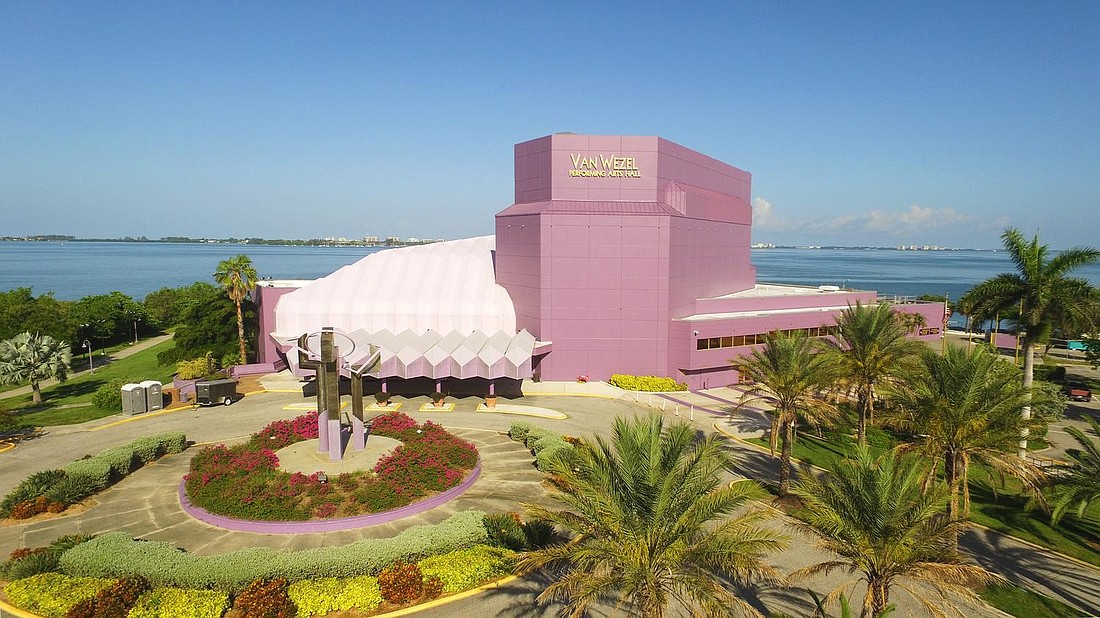- April 4, 2025
-
-
Loading

Loading

Following a summer-long hiatus, the city’s Purple Ribbon Committee was back in session in August with a reminder from facilitator Jim Shirley that the panel seated to recommend repurposing of the Van Wezel Performing Arts Hall still has much work to do by next summer.
In addition to Shirley, committee members were greeted with another face familiar to the Van Wezel, David Karins of Sarasota-based Karins Engineering. The firm developed the Karins Report on the Van Wezel, commissioned by the city in 2021 to study on the condition of the 55-year-old building with estimated costs to waterproof and, if desired, expand the structure to add seating.
Karins has again been retained by the city, this time to take a deeper dive into the Van Wezel to arm the committee with detailed information for options it may consider as adaptive reuse of the facility in the event it is replaced as the city’s primary performance venue by the proposed Sarasota Performing Arts Center.
While the committee was away, the firm has already begun its work, Karins said. That work includes onboarding a team of consultants in a variety of areas.
“We have assembled a really great team to help us with some of the more fine arts-oriented things that us nerdy engineers aren't the best at,” Karins said.
They include:
Now that much of the preliminary work is complete, the finer detail work of the consultants is getting underway.
“We have already commenced the process of putting the steel frame of the shell-shaped portion of the building into a modeling system so that we can evaluate what the current loading impacts are for wind,” Karins told the committee. "We're looking at putting some flood and moving water loads for a 100-year and 500-year event on there.”
Karins was asked what the difference will be between the 2021 report and the new one. He explained the primary difference is in the level of detail and the addition of data from the specialists.
“The difference is that we're not only looking at a general condition and a general opinion of how things are and how long they'll last and what the issues are, we’re actually taking those and putting numbers on the structure,” Karins said.
Those include performance of the structure and upgrades required for operational longevity, flood prevention enhancements, utility systems, elevators, etc. — and, perhaps most importantly, a cost-benefit analysis.
In what capacity the Van Wezel continues to function will in part depend on whether the SPAC is actually built. That first significant step will come by the end of November when a conceptual design and cost estimate by architect Renzo Piano Building Workshop is due. It is the first of the exit ramps the city has to back out of at least the public funding aspect of the project, its share mostly paid for from the surrounding tax increment financing district.
If Renzo Piano's initial work is well received, the implementation agreement between the city and the Sarasota Performing Arts Foundation will be signed.
Meanwhile, the Purple Ribbon Committee’s task runs concurrently, with its mission to recommend to the city whether the Van Wezel should continue as a companion performance venue in a modified form or serve another civic purpose.
The first real progress toward that goal is the completion of Karins Report, the sequel. Karins told the committee he will provide a progress report at its Sept. 10 meeting, when he will accept feedback to be incorporated into the final document.
“We're scheduled to finish in October,” Karins said. “We’re getting into the field work portion of it, and one of the things that might impact that some is that our theater and acoustical consultants would like to be here while there's a performance going on and talk with some of the players and the producers. Those aren't really scheduled to happen until the end of September.”
That may delay for a few weeks that portion of the report, otherwise, “Our field work in earnest is going to be starting shortly, and you'll see folks out there over the next 30 days or so,” he added.
As committee members wrestled with setting their next few meetings — there was some resistance to selecting a September date because of widespread scheduling conflicts — Shirley reminded them of their time constraints to complete their assignment.
“Looking at the work that we have to do, I strongly encourage you to find a September date that works,” he said. “We don't want to get off track here, and we've got a lot of work to do in a short period of time. So I strongly encourage you to find a September date that can work, and then we can make adjustments as needed.”